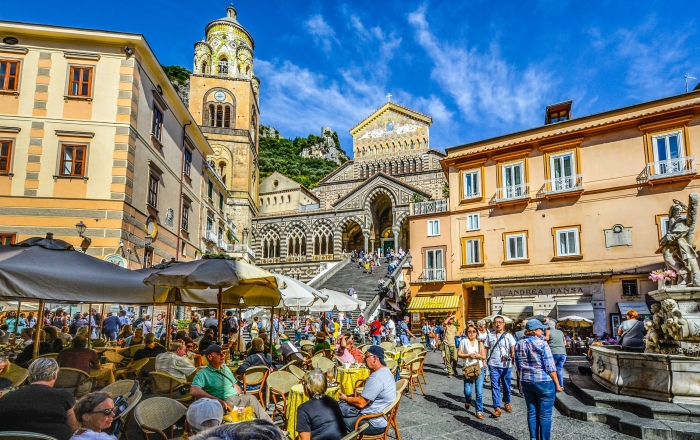
Sorrento
Perched on a cliff overlooking the sea, Sorrento is a marvellous city that will enchant you with its breathtaking views in every season.
The Sorrento coast is one of the most beautiful and suggestive stretches of coastline in Italy, with the scent of lemons, wonderful views and spectacular landscapes attracting travellers from all over the world. The heart of the coast is Sorrento, a pretty town nestled on a rocky terrace that drops a distance of 50 metres sharply down to the sea.
Rich in history, praised by poets both ancient and modern, in the 19th century Sorrento became a popular tourist destination for scholars and artists, kings and emperors, and even today it continues to draw tourists, attracted by the pleasant climate and the outstanding beauty of the landscape.
The shoreline is divided into two parts: the port area of Marina Piccola, where the ferries dock, and the beach of Marina Grande, occupied by seaside establishments. Sorrento is famous for its crystal clear waters and typical Mediterranean vegetation. The coast is peppered with beautiful coves and bays, some of which can only be reached from the sea.
Capo di Sorrento, the limestone promontory that closes the bay of Sorrento to the west, is home to one of the most charming places on the coast, Bagni della Regina Giovanna, a spectacular natural swimming pool which is ideal for taking a refreshing dip, besides being one of the most important archaeological sites on the peninsula. The history of this place dates back to the 1st century B.C. when the villa of Pollio Felice, the ruins of which are still visible, stood on these rocks.
The beating heart of the town is Piazza Tasso, full of bars, restaurants, shops and lots of people practically all year round. The square as we see it today is the result of numerous transformations that have taken place over time. It provides access to the lively old town, crowded with shops and artisan workshops.
Definitely worth a visit are the Cathedral of Santi Filippo e Giacomo, founded in the year one thousand and rebuilt in Renaissance style in the fifteenth century, with a bell tower of Byzantine influence, and the Museo Correale di Terranova, housed in a stunning Baroque villa and filled with precious collections of minor arts from the sixteenth to seventeenth centuries.
 It
It Fr
Fr






